Scroll down
to explore
▼ ▼ ▼
Click anything to see more
There's lots
to explore
▶ ▶ ▶
Tap anything to see more
Cosmic Atlas is © 2018 Alex Read
Images are NASA and ESA.
Hover over an image for specifics.
Images used on Map of the Solar System are all NASA.
Plugins used: jInvertScroll, FancyBox
Cosmic Atlas is non-commercial.
Sun

Mercury

Venus

Earth

Mars

Jupiter

Saturn

Uranus
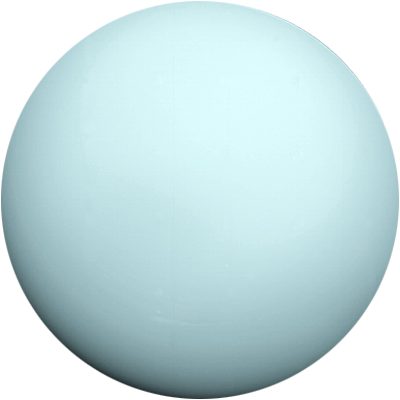
Neptune
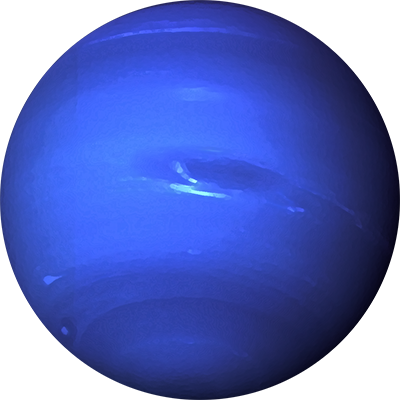

© NASA
Sun
Main sequence star
Diameter
1,391,000 km (over 100x Earth)
Surface temperature
5,505 °C
Core temperature
15,700,000 °C (scorching)
Energy output
384.6 yottawatts (1 second of the Sun's energy could power Earth for millions of years)
The sun is one of billions of stars in the Milky Way. It is, by comparison, small, yellow, and average. But to everything in the solar system, it is the centre of everything.
Our sun, sometimes called Sol, is a giant nuclear reactor. It’s an immense sphere of hydrogen, and under the pressure of its own weight, the hydrogen molecules fuse together into helium, releasing enormous amounts of heat and light. The Sun has been burning like this for over four billion years, and will continue to for another five billion years, before it becomes a red giant and enters the final stages of its life.
The Sun’s huge gravity holds the planets in orbits around it. But the Sun’s influence doesn’t stop with the last planet, it stretches out incredibly far beyond this. The Oort cloud is a gigantic cloud of icy rocks (and who knows what else) loosely held by the Sun’s gravity, and the outer edge may be six thousand times further from the Sun than Neptune.
Other suns
There are around 250 billion stars in the galaxy, but we only call one The Sun. What we’ve found over the past few decades is that nearly all of them, like ours, have planets of their own surrounding them. The most exciting of these are what astronomers call ‘earth-like,’ because if a planet’s conditions appear to match Earth’s, there a chance it could support life.
One of the most exciting of these is the TRAPPIST-1 system, in which astronomers in 2017 discovered four planets in the habitable zoneThe distance from a star that is the right temperature to support life around a small red dwarf star. The planets are probably tidally locked, meaning that one side always faces their sun and is scorching hot, while the other side faces away and is freezing. But on the line between them is where temperatures, if liquid water is found, could be right for life.
And anyway, when scientists look for ‘habitable zones,’ they just mean habitable by life as we know it. who says that Earth-like creatures are the only kind in the universe? There could be all kinds of life just too weird for us to imagine, who could live on planets we couldn’t, so perhaps every star is a sun to something.
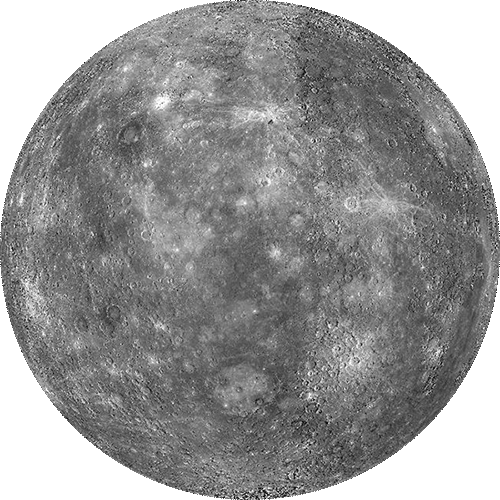
© NASA
Mercury
Rocky Planet
Diameter
4,880 km (small enough to fit between London and New York)
Temperature
-173 °C by night, 427 °C by day
Distance from Sun
58 million km (0.38 AU)1 AU (astronomical unit) is the distance from the Sun to the Earth
Moons
none
Oddest feature
The Sun rises and sets once every two years
Tiny Mercury is the first planet from the Sun. This little, cratered ball of rock has some interesting curiosities.
Being so close to the Sun, Mercury has the shortest year of the planets, at 88 Earth days. Mercury’s rotates so slowly, however, that a single Mercury day lasts 58 Earth days—there’s actually only 1.5 Mercury days in a Mercury year.
Mercury also has the most elliptical orbit of any planet: it could be anywhere from 46,000,000 km to almost 70,000,000 km away from the Sun, depending on where it is in its orbit.
Combined, this creates a weird effect to an observer on the surface of Mercury. Not only does the Sun get bigger as it rises, but it then appears to stop in the sky, and start moving backwards! Then it changes its mind again, and carries on forwards, getting smaller as it goes.
Not quite a dwarf planet, but close
Despite being one of the eight planets, Mercury doesn’t even make the list of top-ten biggest bodies in the solar system. At 4,880 km in diameter, Mercury is actually smaller than two moons in the Solar System: Saturn’s Titan, and Jupiter’s Ganymede, the biggest.
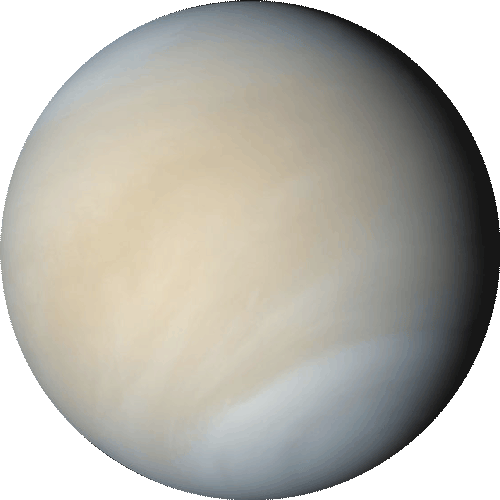
© NASA
Venus
Rocky Planet
Diameter
12,104 km (a little smaller than Earth)
Temperature
462 °C (toasty)
Distance from Sun
108 million km (0.73 AU)1 AU (astronomical unit) is the distance from the Sun to the Earth
Moons
none
Nickname
The Morning Star or Evening Star (because that's when it's visible from Earth)
Venus is Earth’s sister planet—but there’s no doubting which is the fairer sibling.
With an atmosphere four times thicker than Earth’s, a runaway greenhouse effect has made Venus into a kind of hell, at 462 °C all over. Surface pressure from the carbon dioxide atmosphere is a crushing 90 times higher than that on Earth, and to top it off the clouds are made of acid.
From the outside, those acidic clouds make for a beautiful, gleaming disc. You can sometimes see it from Earth, around sunrise and sunset, brighter than any star.
Curiously, Venus rotates in the opposite direction to every other planet, so the Sun rises in the west (or it would if you could see through the clouds). We aren’t quite sure why, but its possible the Sun’s gravity pulled on Venus’ dense atmosphere, causing it to flip upside down.
Sunrise wouldn’t be very common on Venus even if you could see it through the dense clouds, as it takes 243 Earth days to rotate once, the slowest rotation of any planet. In fact, a Venusian day is longer than a Venusian year (225 Earth days).
Exploration
Unsurprisingly for such a hostile world, exploration of Venus has been difficult. The first landers, sent by the Soviets in the 1970s, operated for less than an hour before failing.
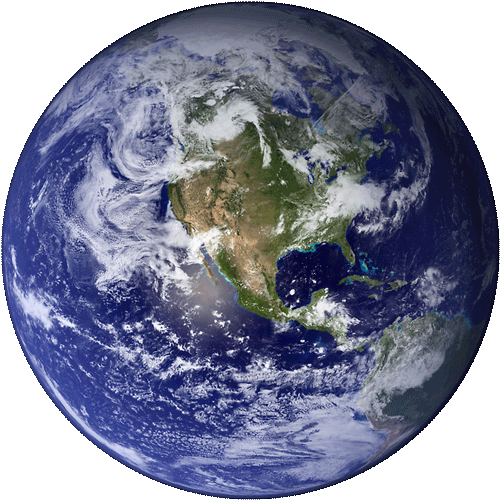
© NASA
Earth
Rocky Planet
Diameter
6778 km
Temperature
210 K
Distance from Sun
150 million km (1 AU)1 AU (astronomical unit) is the distance from the Sun to the Earth
Moons
1 big one
Unique feature (as far as we know)
Life
Our home, the blue planet, is dominated by water. Here, 150,000,000 km from the Sun, conditions are just right to give rise to life.
Earth’s interior is a mantle of hot molten rock, on top of which sit the tectonic plates that make up the planet’s crust. It is the movement of these plates which cause the continents of Earth to move over millions of years. At places where the plates meet,
Even at the bottom of oceans, the heat of hydrothermic vents can support life. The immense pressure of kilometres of water make this environment inhospitable to surface beings like us, and yet ever-weirder creatures call it their home— in fact, this is probably where life started. It makes one wonder – where else in might life exist? After all, Earth’s isn’t the only ocean on the solar system (see: Jupiter’s moon Europa).
The Moon
Earth is the only one of the smaller, rocky planets to have a big moon. It comes from an event early in the planet's history, it collided with another young planet, Theia. The cataclysmic impact threw massive amounts of debris into orbit, where it formed together into the Moon.
Today, not only is the Moon the main driver behind the Earth's important tides, but it gives us wondrous eclipses: a solar eclipse is when the Moon passes between the Earth and the Sun, blocking it out.
This can only happen because, by a strange coincidence, the Sun is both 400 times bigger and 400 times further away! This perfect alignment will last for another 600 million years before the Moon drifts too far away from Earth.

© NASA
Mars
Rocky Planet
Diameter
6778 km (around half of Earth)
Temperature
−55 °C (average - can get as high as 20 °C)
Distance from Sun
228 million km (1.52 AU)1 AU (astronomical unit) is the distance from the Sun to the Earth
Moons
2 (tiny)Phobos and Diemos
Most striking feature
The biggest volcano in the solar system
The Red Planet is humans’ first goal for colonisation, and fascinates us for its potential to harbour water, and with it, life.
With a diameter of little more than half of Earth's, and coloured red from its oxidised iron rocks, you would be forgiven for thinking that Mars bears no similarities to its much livelier neighbour. Yet, some things are familiar.
An atmosphere exists, not as thick as Earth’s, but enough to fuel a wind system, where storms whip up the dusty surface. Ice caps rest on the north and south poles of the planet: not just water ice, but frozen carbon dioxide forming a top later. Canyons, one running like a giant scar across the planet’s face, are balanced by mountains: Olympus Mons, the biggest volcano in the solar system, is three times higher than Earth’s Mount Everest.
Rovers
Perhaps the most successful (certainly the most persistent) rover that we've sent to Mars is Opportunity, which landed in January 2004 and has been driving around the Martian surface ever since. It's driven 40 km as of 2018, which may not sound much but it is the furthest any vehicle has driven on another world.
More recently in 2011, NASA have sent the much larger Curiosity, and two more rovers are planned to be launched in 2020: one by NASA, and one by the European Space Agency, in collaboration with the Russian Roscosmos.
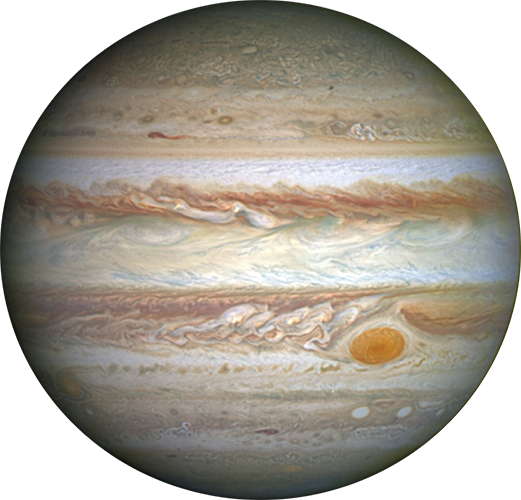
© NASA
Jupiter
Gas Giant
Diameter
139,822 km (huge)
upper cloud layer temperature
–108 °C
Distance from Sun
779 million km (5.2 AU)1 AU (astronomical unit) is the distance from the Sun to the Earth
Moons
69(known as of 2018)
Most striking feature
The Great Red Spot, a gigantic storm that could swallow Earth
Jupiter is big. So big that you could add all the other planets together, twice, and it still wouldn’t even compare.
Jupiter is mostly gas, hydrogen and helium. At the centre, the enormous pressure from the rest of the planet compress the hydrogen gas into a solid core.
The layers above are rapidly whirling storms. The bands around Jupiter are layers of these storms, with different chemicals, and you can see them move from Earth. The fiercest storm in the solar system is the Great Red Spot, and it's been going since at least 1610 when we first saw it.
It’s thought that Jupiter’s size protects Earth. Its huge mass catches stray comets and asteroids, and keeps them from entering the inner solar system. Without our big brother Jupiter, life on Earth probably wouldn’t be possible.
Galilean Moons
The largest four of Jupiter's moons are well worth a look.
Ganymede is the largest moon in the solar system. Despite this, it looks half the size of Io from Jupiter's surface, because it's further away.
Callisto is a heavily cratered rock, with huge ringed impact structures called Valhalla and Asgard.
Europa's curious, lined surface is young, so astronomers think there must be some kind of geological activity underneath. Soon we'll be sending probes, to see if there's really liquid ocean hidden under the ice.
Io is the smallest of the four, but fiery hot: it has the only known active volcanoes in the solar system, apart from Earth's.
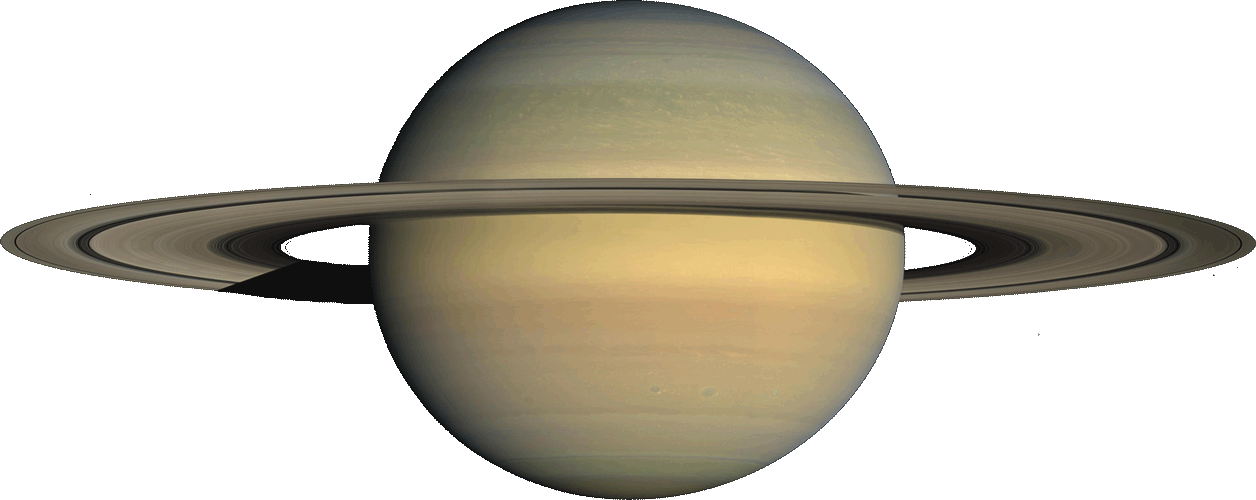
© NASA
Saturn
Gas Giant
Diameter
116,464 km
Upper cloud temperature
–139 °C
Distance from Sun
1,422 million km (9.6 AU)1 AU (astronomical unit) is the distance from the Sun to the Earth
Moons
62 (known as of 2018)(plus countless 'moonlets')
Funnest feature
It could float in water, if you had a big enough bath
The crown jewel of the solar system, Saturn and its complex moon and ring system are a sight to behold—and we might just be beginning to discover some of its wonders.
Saturn is similar to Jupiter in many ways, also being composed of gas, with a solid core. The incredible winds in the outer atmosphere can reach 1,800 km/h(1,100 mph).
The famous rings are made mostly of icy particles, with a few rocks thrown in. Some of Saturn's 62 moons orbit in between parts of the rings, and some act as 'shepherd moons,' stopping the rings from spreading out.
Titan
Titan, the second biggest moon in the solar system, is interesting for other reasons too. Unique among moons, it has a very thick atmosphere (so thick you could fly just by flapping your arms), liquid lakes, and even rain! It's not water that falls, though: at –179 °C, this is liquid methane.
The European Space Agency sent a probe, Huygens, that landed on Titan in 2005, and sent back the first images from the surface a world in the outer solar system.
Iapetus
Iapetus is Saturn’s third largest moon, and well worth a visit. Why? Because Iapetus orbits Saturn at a higher angle than the rest, so while most moons see only the edge of the rings, Iapetus looks down on or up to them—making Iapetus the place with the best view in the solar system.
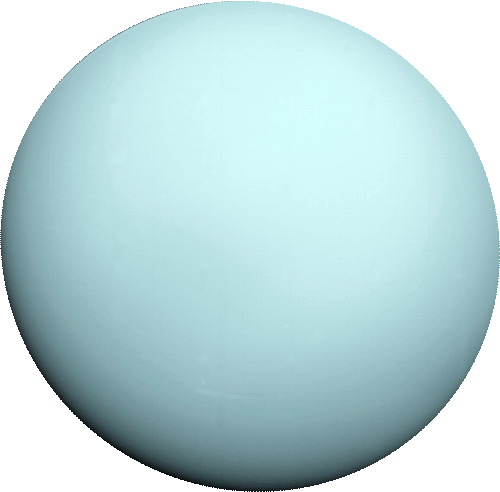
© NASA
Uranus
Ice Giant
Diameter
50,724 km
Upper cloud temperature
–216 °C
Distance from Sun
2,875 million km (19.2 AU)1 AU (astronomical unit) is the distance from the Sun to the Earth
Moons
27 (known as of 2018)
Oddest feature
Tilted sideways, like it's having a lie-down
The two furthest planets from the Sun are called the Ice Giants. Appropriately, Uranus is colder than all the rest, and the oddities don't end there.
Not only does the planet spin the opposite direction to most planets, it does so on its side. That is, Uranus' north and south poles sometimes point almost directly at the Sun. Because Uranus takes 84 years to orbit the Sun, this means the poles alternately spend 42 years looking at the Sun, and 42 years unable to see it.
Uranus has rings. Actually, all of the giant planets have a few small rings, but none quite like Saturn's. Uranus' comes in two sets, and were discovered in 1977.
A Literary Litany of moons
All of Uranus' moons are named after characters from Shakespeare plays, including the five biggest: Miranda, Ariel, Umbriel, Titania, and Oberon.
The closest to Uranus, Miranda, is particularly pretty, with huge, towering, icy cliffs and craters. One of the cliffs, Verona Rupes, is over 5 km high—imagine standing on top of that.
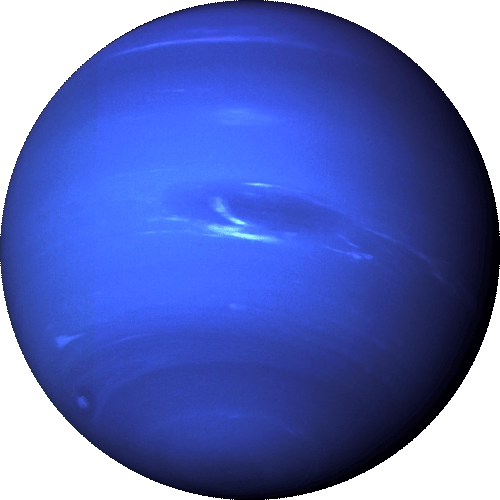
© NASA
Neptune
Ice Giant
Diameter
49,528 km
Upper cloud temperature
–214 °C
Distance from Sun
4,500 million km (30.1 AU)1 AU (astronomical unit) is the distance from the Sun to the Earth
Moons
14 (known as of 2018)
Bluest feature
All of it
We're at the outer reaches of the solar system. Billions of kilometers from the Sun, our star looks like no more than a bright star. Welcome to the solar system's other Blue Marble.
Methane in Neptune's atmosphere absorbs red light from the sun, but reflects blue light, making it the bluest thing you're likely to see through a telescope.
Neptune has huge and violent storms called Great Dark Spots, to mirror Jupiter's Great Red Spot. The Great Dark Spots don't last as long: only a few years, and new ones occasionally appear on the surface.
These dynamic storm systems give it the highest winds in the solar system: 2,200 km/h1,300 mph, making them almost supersonic.
The white spots on Neptune are patches of cloud. One is known as 'the scooter' because it travels around the planet faster than other features.
Triton
Triton is by far Neptune's biggest moon, and may be the coldest place in the solar system, and –235 °C, just 35 degrees above absolute zero. It's one of only two moons in the solar system to have an atmosphere (though it's not as thick as Titan's).
But perhaps most exciting is the ice volcanoes. These volcanoes shoot out liquid nitrogen, which freezes and combines to make giant shards of freezing gas.